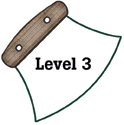
Alaska Science
Key Element C3
A student who meets the content standard should understand that society, culture, history, and environment affect the development of scientific knowledge.
 |
Alaska Science A student who meets the content standard should understand that society, culture, history, and environment affect the development of scientific knowledge. |
|
Performance Standard Level 3, Ages 11–14
|
|
|
|
Sample Assessment Ideas
|
Standards Cross-References
|
||
|
National Science Education Standards Many different people in different cultures have made and continue to make contributions to science and technology. (Page 166) Science and technology are reciprocal. Science helps drive technology, as it addresses questions that demand more sophisticated instruments and provides principles for better instrumentation and technique. Technology is essential to science, because it provides instruments and techniques that enable observations of objects and phenomena that are otherwise unobservable due to factors such as quantity, distance, location, size, and speed. Technology also provides tools for investigations, inquiry, and analysis. (Page 166) Societal challenges often inspire questions for scientific research, and social priorities often influence research priorities through the availability of funding for research. (Page 169) Societal challenges often inspire questions for scientific research, and social priorities often influence research priorities through the availability of funding for research. (Page 169) Science and technology have advanced through the contributions of many different people, in different cultures, at different times in history. Science and technology have contributed enormously to economic growth and productivity among societies and groups within societies. (Page 169) Women and men of various social and ethnic backgrounds, and with diverse interest, talents, qualities, and motivations, engage in the activities of science, engineering, and related fields such as the health professions. Some scientists work in teams, and some work alone, but all communicate extensively with others. (Page 170) Many individuals have contributed to the traditions of science. Studying some of these individuals provides further understanding of scientific inquiry, science as a human endeavor, the nature of science, and the relationships between science and society. (Page 171) In historical perspective, science has been practiced by different individuals in different cultures. In looking at the history of many peoples one finds that scientist and engineers of high achievement are considered to be among the most valued contributors to their culture. (Page 171) |
Benchmarks Some scientific knowledge is very old and yet still applicable today (Page 7) Important contributions to the advancement of science, mathematics, and technology have been made by different kinds of people, in different cultures, at different times. (Page 17) No matter who does science and mathematics or invents things, or when or where they do it, the knowledge and technology that result can eventually become available to everyone in the world. (Page 17) |
|
Table of Contents | Return to Alaska Native Knowledge Network